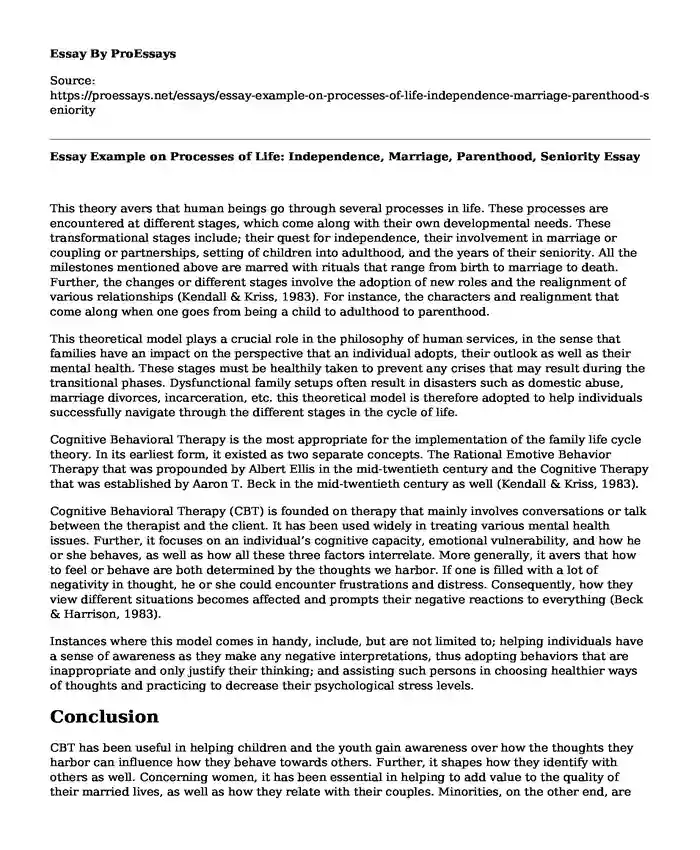This theory avers that human beings go through several processes in life. These processes are encountered at different stages, which come along with their own developmental needs. These transformational stages include; their quest for independence, their involvement in marriage or coupling or partnerships, setting of children into adulthood, and the years of their seniority. All the milestones mentioned above are marred with rituals that range from birth to marriage to death. Further, the changes or different stages involve the adoption of new roles and the realignment of various relationships (Kendall & Kriss, 1983). For instance, the characters and realignment that come along when one goes from being a child to adulthood to parenthood.
This theoretical model plays a crucial role in the philosophy of human services, in the sense that families have an impact on the perspective that an individual adopts, their outlook as well as their mental health. These stages must be healthily taken to prevent any crises that may result during the transitional phases. Dysfunctional family setups often result in disasters such as domestic abuse, marriage divorces, incarceration, etc. this theoretical model is therefore adopted to help individuals successfully navigate through the different stages in the cycle of life.
Cognitive Behavioral Therapy is the most appropriate for the implementation of the family life cycle theory. In its earliest form, it existed as two separate concepts. The Rational Emotive Behavior Therapy that was propounded by Albert Ellis in the mid-twentieth century and the Cognitive Therapy that was established by Aaron T. Beck in the mid-twentieth century as well (Kendall & Kriss, 1983).
Cognitive Behavioral Therapy (CBT) is founded on therapy that mainly involves conversations or talk between the therapist and the client. It has been used widely in treating various mental health issues. Further, it focuses on an individual’s cognitive capacity, emotional vulnerability, and how he or she behaves, as well as how all these three factors interrelate. More generally, it avers that how to feel or behave are both determined by the thoughts we harbor. If one is filled with a lot of negativity in thought, he or she could encounter frustrations and distress. Consequently, how they view different situations becomes affected and prompts their negative reactions to everything (Beck & Harrison, 1983).
Instances where this model comes in handy, include, but are not limited to; helping individuals have a sense of awareness as they make any negative interpretations, thus adopting behaviors that are inappropriate and only justify their thinking; and assisting such persons in choosing healthier ways of thoughts and practicing to decrease their psychological stress levels.
Conclusion
CBT has been useful in helping children and the youth gain awareness over how the thoughts they harbor can influence how they behave towards others. Further, it shapes how they identify with others as well. Concerning women, it has been essential in helping to add value to the quality of their married lives, as well as how they relate with their couples. Minorities, on the other end, are aided indirectly by this model. It teaches the supremacists on how to view those that are regarded as a minority in society (Beck & Harrison, 1983). Through this, the way they relate is instantly improved.
The Cognitive Behavioral Therapy provides a framework or platform within which the Family Life Cycle theory operates. The impact they have on delivering essential human services to those in need cannot be understated.
References
Best_Schools. (2019, December 03). 12 Common Social Work Theories...and 5 Major Practice Models-Study Starters. Retrieved June 21, 2020, from https://thebestschools.org/magazine/common-social-work-theories-and-practice-models/
Kendall, P. C., & Kriss, M. R. (1983). Cognitive-behavioral interventions. In: C. E. Walker, ed. The handbook of clinical psychology: theory, research and practice, pp. 770–819. Homewood, IL: Dow Jones-Irwin.
Beck, A. T., Epstein, N., & Harrison, R. (1983). Cognitions, attitudes and personality dimensions in depression. British Journal of Cognitive Psychotherapy.
Cite this page
Essay Example on Processes of Life: Independence, Marriage, Parenthood, Seniority. (2023, Sep 10). Retrieved from https://proessays.net/essays/essay-example-on-processes-of-life-independence-marriage-parenthood-seniority
If you are the original author of this essay and no longer wish to have it published on the ProEssays website, please click below to request its removal:
- Some Questions on Counseling and Psychotherapy
- How Does Cyberbullying Affect the Youth Mental Health? - Annotated Bibliography
- Empathy, Narrative, and Victim Impact Statements Paper Example
- Extrapyramidal Side Effects and Neuroleptic Malignant Syndromes Essay
- Paper Example on Personal Ethics, Values and Orientation to Counseling
- Essay Sample on Safeguarding Tendencies: Adler's Neurotic Lifestyle
- Reprogram My Preferences - Essay Sample







